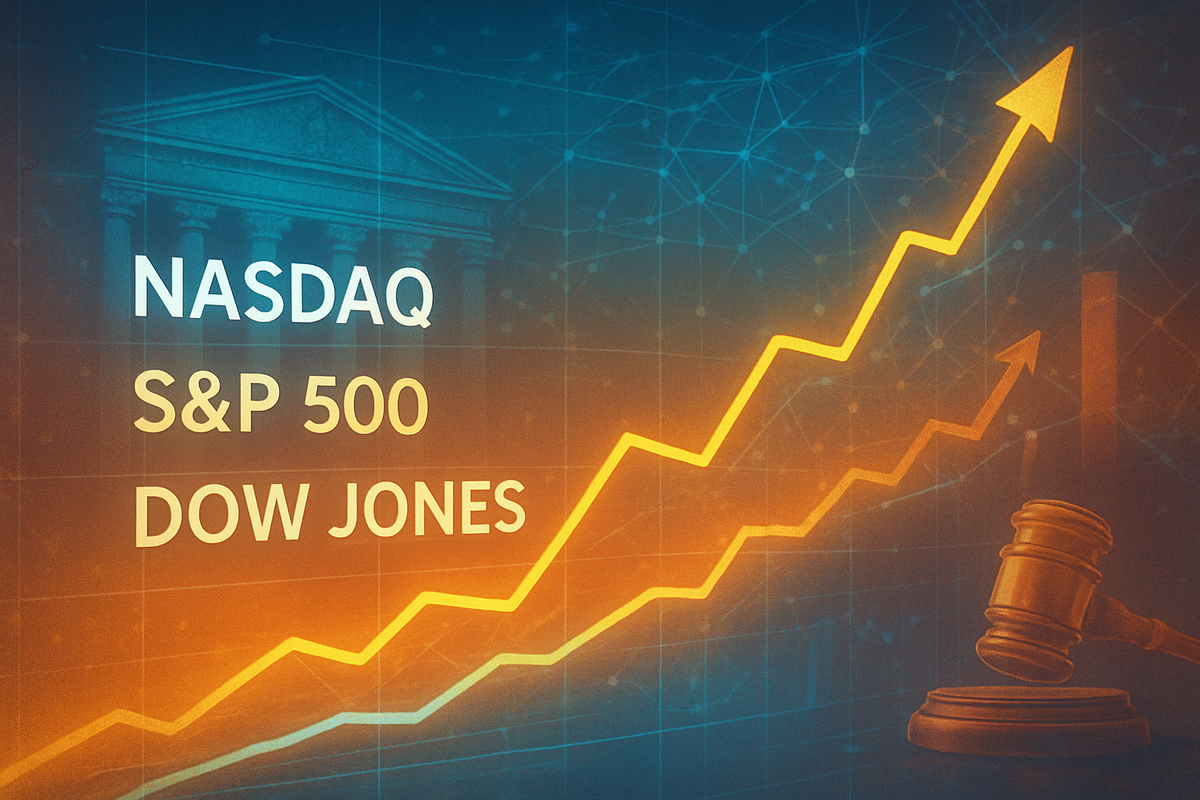
The U.S. stock market concluded November 2025 with a powerful surge, as the Nasdaq Composite (NASDAQ: IXIC), S&P 500 (NYSEARCA: SPY), and Dow Jones Industrial Average (NYSEARCA: DIA) all staged a remarkable rally to erase significant portions of their earlier monthly losses. This late-month resurgence, fueled by renewed optimism surrounding potential Federal Reserve interest rate cuts and a strong rebound in technology stocks, provided a much-needed boost to investor sentiment, setting a cautiously optimistic tone for the close of the year. The impressive turnaround saw major indices not only recover but also achieve notable winning streaks, signaling a potential shift in market dynamics.
This dramatic rally carries immediate implications for investors, suggesting a renewed "risk-on" sentiment returning to global markets. The prospect of a more dovish Federal Reserve, coupled with the end of quantitative tightening, is expected to inject liquidity, supporting equities and real estate. While not all indices fully recouped their November losses by month-end, the sheer force of the rebound underscores the market's underlying resilience and its sensitivity to monetary policy expectations and technological advancements, particularly in the burgeoning field of artificial intelligence.
A Week of Resurgence: Indices Climb on Fed Hopes and Tech Revival
The closing days of November 2025 witnessed a significant and broad-based rally across Wall Street's major indices, driven by a confluence of factors that reversed earlier monthly declines. The tech-heavy Nasdaq Composite (NASDAQ: IXIC) led the charge, demonstrating robust gains, while the S&P 500 (NYSEARCA: SPY) and Dow Jones Industrial Average (NYSEARCA: DIA) also posted strong performances, culminating in a four-day winning streak that injected palpable optimism into the market.
The rally gained significant traction on Monday, November 24th, when the Nasdaq Composite soared 2.7%, the S&P 500 climbed 1.6%, and the Dow Jones Industrial Average rose 0.4%, adding 200 points. This momentum continued throughout the week, extending Wall Street's winning streak into Wednesday, November 26th. By this point, the S&P 500 had risen 0.7% to close at 6,812.61, the Dow Jones Industrial Average gained 0.7% (314.67 points) to finish at 47,427.12, and the Nasdaq Composite added 0.8% to reach 23,214.69. The positive trend persisted into the shortened Black Friday session on November 28th, with all three indices opening higher.
A primary catalyst for this late-month surge was the growing expectation of a Federal Reserve interest rate cut at its upcoming December meeting. Statements from New York Fed President John Williams, signaling support for an additional rate cut and indicating the end of quantitative tightening, significantly bolstered investor confidence. This dovish shift by the Fed, interpreted as a move to support economic growth, spurred a "risk-on" environment. Simultaneously, artificial intelligence (AI) related stocks experienced a strong rebound. Earlier in November, concerns over inflated AI valuations had led to a sell-off, with key players like Nvidia (NASDAQ: NVDA) seeing declines despite strong earnings. However, the rally saw a resurgence in these tech giants, with Google parent Alphabet (NASDAQ: GOOGL) jumping significantly after unveiling its Gemini 3 AI model and reports of talks with Meta Platforms (NASDAQ: META). Dell Technologies (NYSE: DELL) also climbed on record orders for its AI servers, highlighting the continued strong demand for AI infrastructure.
While the late-November rally was powerful, it wasn't enough to completely erase all monthly losses for all indices. By the close of Friday, November 28th, the Nasdaq Composite (NASDAQ: IXIC) remained down nearly 2% for the month, ending its impressive seven-month winning streak. The S&P 500 (NYSEARCA: SPY) was marginally lower for November, marking its first decline after six consecutive monthly gains. The Dow Jones Industrial Average (NYSEARCA: DIA), however, managed to finish nearly flat for the month, showcasing its relative stability. This mixed outcome underscores the volatility that characterized November, despite the strong finish.
Potential Winners and Losers in the Wake of the Rally
The late-November stock market rally, driven by expectations of Federal Reserve rate cuts and a resurgence in AI-related technology, is poised to create distinct winners and losers across various sectors and companies. The shift towards a more dovish Fed policy typically benefits growth-oriented sectors, while the sustained interest in artificial intelligence continues to reshape the competitive landscape.
Technology companies, particularly those at the forefront of artificial intelligence development and infrastructure, are clear beneficiaries. Companies like Nvidia (NASDAQ: NVDA), despite earlier November jitters regarding AI valuations, are likely to see renewed investor confidence as demand for their high-performance GPUs remains robust. Alphabet (NASDAQ: GOOGL), with its unveiling of the Gemini 3 AI model and strategic discussions with Meta Platforms (NASDAQ: META), stands to gain significantly from increased AI adoption and potential new revenue streams. Similarly, Dell Technologies (NYSE: DELL), reporting record orders for its AI servers, is well-positioned to capitalize on the foundational hardware needs of the AI boom. These companies, along with other semiconductor manufacturers and software providers in the AI space, are expected to continue their upward trajectory as the market embraces the long-term potential of AI.
Beyond the immediate tech sphere, sectors sensitive to interest rates are also likely to benefit. The prospect of lower borrowing costs makes growth stocks more attractive, as their future earnings are discounted at a lower rate. This could lead to a broader rally in innovative companies across various industries. Additionally, the housing market and real estate investment trusts (REITs) could see a boost from reduced mortgage rates and improved financing conditions, making real estate investments more appealing to both consumers and institutional investors. Financial institutions might experience mixed effects; while lower rates could compress net interest margins, increased lending activity and a healthier economic outlook could offset these pressures, particularly for those with diversified revenue streams.
Conversely, some sectors might face headwinds or see their advantages diminish. Defensive stocks, often favored during periods of uncertainty or rising interest rates, might see reduced investor interest as a "risk-on" sentiment prevails. Utilities and consumer staples, while stable, typically offer lower growth potential compared to technology and growth stocks, making them less appealing in a bullish market driven by speculative growth. Furthermore, companies with high levels of debt that have not yet refinanced could still face challenges, even with the prospect of future rate cuts, if their current debt servicing costs remain elevated. The ongoing volatility, despite the rally, also means that companies with weaker fundamentals or those highly exposed to geopolitical risks could still underperform.
The rally also highlights the potential for market concentration risks. If the rally continues to be disproportionately driven by a handful of mega-cap technology stocks, it could lead to an increasingly top-heavy market, similar to historical precedents. This could mean that while index-level performance looks strong, many smaller and mid-cap companies might not participate equally in the gains, potentially creating a disparity in wealth creation for investors. The sustainability of this tech-led rally will depend heavily on continued innovation, robust earnings growth from these companies, and a broadening of market participation.
Wider Significance: A Shift in Market Dynamics and Future Trends
The late-November stock market rally represents more than just a temporary rebound; it signals a potential shift in broader market dynamics and could have significant implications for future industry trends, regulatory considerations, and economic policy. The confluence of dovish Federal Reserve expectations and the sustained enthusiasm for artificial intelligence is reshaping investor psychology and capital allocation.
This event fits squarely into the broader trend of markets being highly sensitive to central bank policy. The pivot towards potential interest rate cuts, following a period of aggressive tightening, suggests the Fed is becoming more responsive to economic data indicating slowing inflation and potential growth deceleration. This "Fed put" phenomenon, where markets anticipate central bank intervention to prevent significant downturns, can create a powerful tailwind for equities. It also highlights a growing divergence between the real economy and financial markets, where monetary policy expectations often overshadow fundamental economic indicators in the short term. The end of quantitative tightening, as indicated by Fed officials, is particularly significant as it implies an increase in market liquidity, a critical factor for supporting asset prices.
The ripple effects of this rally are likely to be felt across various sectors. Competitors to the leading AI firms, such as other semiconductor companies or cloud service providers, will face intensified pressure to innovate and demonstrate their value proposition in the rapidly evolving AI landscape. Companies that are slow to integrate AI into their operations or products could find themselves at a competitive disadvantage. Partners of these tech giants, such as data centers, component suppliers, and software developers, are poised for continued growth as the demand for AI infrastructure and applications expands. This rally could also accelerate M&A activity, as larger tech companies seek to acquire smaller, innovative AI startups to bolster their capabilities.
From a regulatory and policy perspective, the sustained AI boom and the market's reliance on a few dominant tech players could attract increased scrutiny. Concerns about monopolistic practices, data privacy, and the ethical implications of advanced AI models may lead to calls for stricter regulations. Governments worldwide are already grappling with how to govern AI, and a market rally heavily concentrated in this sector could expedite policy debates and potential legislative action. Furthermore, the Fed's dovish stance might also invite political pressure, with some arguing that monetary policy is being influenced by market demands rather than purely economic fundamentals. Historically, periods of rapid technological advancement coupled with accommodative monetary policy have often led to asset bubbles, a precedent that regulators and investors will be keenly watching.
What Comes Next: Navigating Opportunities and Challenges
Looking ahead, the late-November stock market rally sets the stage for a complex interplay of short-term possibilities and long-term strategic adaptations. The immediate future will likely be dominated by continued speculation surrounding the Federal Reserve's next moves and the ongoing narrative of artificial intelligence's transformative power.
In the short term, investors will be keenly focused on the upcoming December Federal Open Market Committee (FOMC) meeting. Any concrete signals or actions regarding interest rate cuts will be paramount in determining market direction. A confirmed dovish pivot could sustain the "risk-on" sentiment, potentially leading to a year-end rally or "Santa Claus rally" into early 2026. Conversely, any unexpected hawkish comments or a delay in rate cuts could trigger renewed volatility and profit-taking. The performance of AI-related stocks will also remain a critical barometer; continued strong earnings and positive developments, like further advancements in AI models or new commercial applications, could keep the tech sector buoyant. However, any signs of overvaluation or a slowdown in demand could quickly reverse recent gains.
Longer-term, companies will need to strategically pivot and adapt to a market increasingly shaped by AI and potentially lower interest rate environments. Non-tech companies, in particular, will face pressure to integrate AI into their operations to enhance efficiency, reduce costs, and develop new products or services. This could lead to significant capital expenditures in technology and a re-evaluation of business models. For investors, market opportunities may emerge in sectors that are early adopters of AI or those that provide essential infrastructure for the AI ecosystem. Challenges include navigating potential regulatory hurdles for AI, managing cybersecurity risks associated with advanced technologies, and identifying sustainable growth drivers beyond the initial AI hype. The potential for market concentration also poses a long-term challenge, requiring investors to diversify carefully and assess individual company fundamentals rather than relying solely on broad market trends.
Potential scenarios and outcomes for the coming months vary widely. A "soft landing" scenario, where inflation is tamed without a significant recession, coupled with Fed rate cuts, could lead to a sustained bull market. In this scenario, both growth and value stocks could perform well, and the rally could broaden beyond mega-cap tech. Alternatively, a "bumpy landing" or a mild recession, despite Fed easing, could introduce renewed volatility, challenging the current optimism. Furthermore, geopolitical events or unexpected economic data could quickly shift market sentiment. Investors should prepare for continued market dynamism, characterized by periods of rapid gains and potential pullbacks, as the market digests new information and adjusts to evolving economic and technological landscapes.
Comprehensive Wrap-Up: Assessing the Market's Trajectory
The late-November stock market rally, characterized by a significant rebound in the Nasdaq (NASDAQ: IXIC), S&P 500 (NYSEARCA: SPY), and Dow (NYSEARCA: DIA), offers several key takeaways for investors and market watchers. The most prominent is the profound influence of monetary policy expectations on market sentiment; the mere prospect of Federal Reserve interest rate cuts proved to be a powerful catalyst, overriding earlier concerns and driving substantial gains. This underscores the market's inherent sensitivity to the cost of capital and liquidity. Equally significant is the enduring strength and transformative potential of artificial intelligence, which continues to be a dominant theme, propelling the performance of key technology companies.
Moving forward, the market appears poised for a period of cautious optimism, albeit with an underlying current of potential volatility. While the impressive recovery has instilled confidence, the fact that not all indices fully erased their November losses by month-end serves as a reminder of the nuanced challenges that remain. The market's ability to absorb earlier selling pressure and stage a strong comeback speaks to its resilience, yet the concentration of gains in a few mega-cap tech stocks also highlights potential risks of a narrow rally. The interplay between monetary policy, technological innovation, and broader economic indicators will dictate the market's trajectory in the coming months.
The lasting impact of this rally could be a reinforced belief in the long-term growth potential of the technology sector, particularly AI, and a renewed emphasis on the Federal Reserve's role as a market stabilizer. Investors should watch closely for further signals from the Federal Reserve regarding interest rates and quantitative tightening, as these will likely be the primary drivers of market sentiment. Additionally, monitoring the earnings reports and innovation pipelines of leading AI companies will be crucial for assessing the sustainability of the tech-led rally. Finally, diversifying portfolios and maintaining a long-term perspective will be essential to navigate the opportunities and challenges that will undoubtedly emerge in the dynamic financial landscape of early 2026.
This content is intended for informational purposes only and is not financial advice




